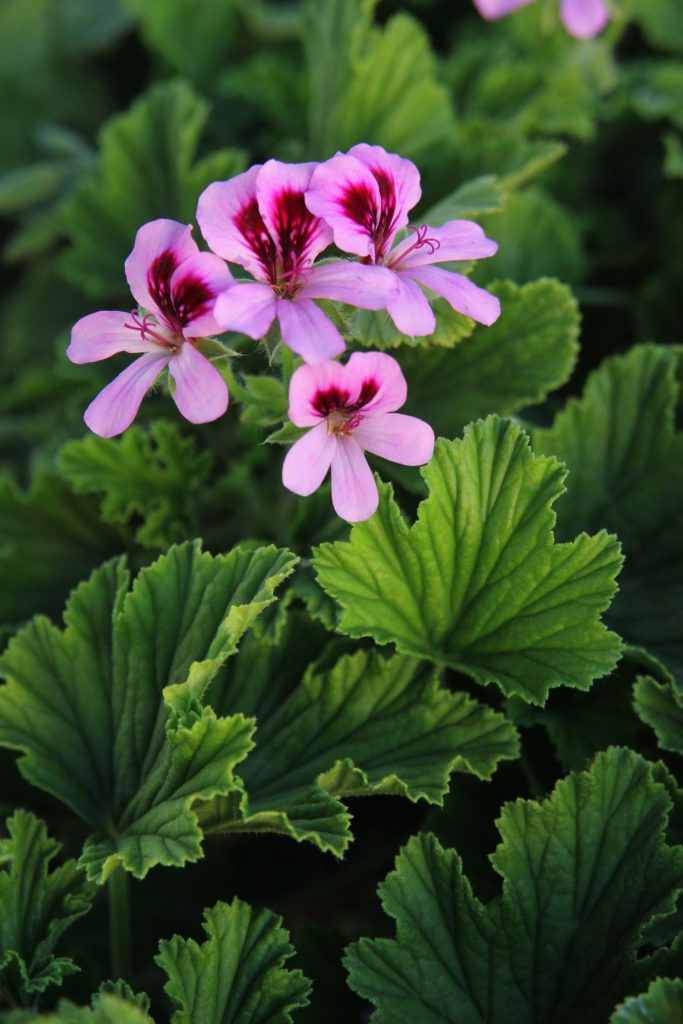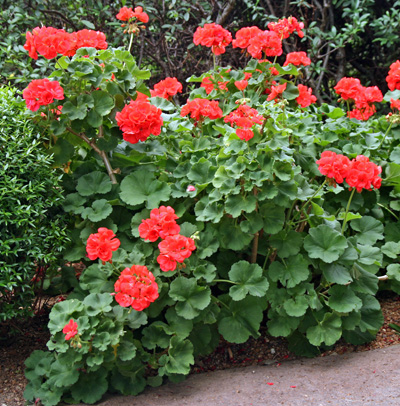As I look out at my patio, I am faced with the decision to either overwinter my potted tender geraniums (Pelargonium spp.) or send them to the compost. They continue to present a beautiful display of blooms even with the recent below freezing temperatures.
I started these geraniums from seed last winter. After tending them for months then potting them up and placing them outside where they flowered all summer long; it’s just not that easy to see them perish. So, I think I will try to overwinter my geraniums. Geraniums are as robust as they are attractive. Overwintering them is not difficult and there are three basic methods on how to do it. The first method is to just bring them indoors and maintain them as a houseplant. If they are in a garden bed, carefully dig them up before a hard freeze and place them in a properly sized pot. For geraniums already in a container, just move them indoors. Always check for any unwanted hitchhikers.
Once indoors, trim the plants back by one-third to one-half, water thoroughly and set in a sunny spot. If you lack space near a bright window, you can use artificial lighting, or a combination of natural and artificial light. Keep the geraniums away from heat vents or the fireplace as they fare much better in cooler temperatures (60 to 65 degrees F). If your plants start looking “leggy”, which often happens with reduced light, prune or “pinch back” stems just above a leaf node to produce new growth. Water the geraniums when the soil feels dry to the touch.
The second way to overwinter geraniums is to take cuttings. This method works especially well if you have limited space and can’t overwinter large pots. Use a sharp knife and cut off a 3 to 4inch section of the plant’s stem tip. Pinch off the lower leaves and dip the cut end in a rooting hormone. Rooting hormone mixtures are available at most garden centers. Place the cutting in a rooting medium like peat moss, sand or perlite. You can also buy a commercial rooting mix. Water the medium well and let it drain (make sure the container you use has drainage holes). Keep the medium moist so the cutting doesn’t dry out. Set it in a brightly lit area but not in direct sunlight as this can burn the cutting.

Pelargonium hyb.
Cuttings should be well-rooted after about 6 weeks. Once rooted, transplant each cutting into their own container filled with potting soil. Place the newly potted geraniums in a bright spot and water thoroughly when the soil becomes dry.

The last method for overwintering geraniums is one my mom’s grandmother practiced. This method entails digging up the plants (again before a hard freeze) and then gently shaking the soil from the roots. The plants are then stored hung upside down in a cool (45° to 55°F), dry location. In my greatgran’s time, folks had fruit cellars, which worked well as a place to store dormant geraniums. The temperature stayed cool and it wasn’t too dry. Today, an unheated room, indoor porch, cool basement or garage may work. You can also store the plants in a large, paper bag if you don’t have a suitable place to hang them. Keep the bag open to allow for good air circulation. Don’t be surprised when the leaves start to dry up and fall off. This is probably going to happen.
Some gardeners will soak the dormant plant’s roots in water for a few hours several times throughout the winter to prevent the roots from completely drying out. After soaking, the plants are hung back up or placed back in the paper bag. I plan to overwinter my geraniums using the bare-root method. As I have not used this method before, I may try both options. I’ll soak a few of the plants’ roots and will leave others to stay dry through the winter and will see if there is a difference in how the plants perform in the spring.
Geraniums overwintered using the bare-root method should be cut back in March. Prune to about one-third of its original height or to firm, green, live tissue. Remove any dead or withered material. Pot up each plant and water thoroughly. Place the potted geraniums in a brightly lit spot and keep your fingers crossed. Plants overwintered in this manner may take a while before they begin growing again. Storing bare-root geraniums can be a challenge. You might want to experiment with several plants and take cuttings just in case the original plants don’t survive.
With whatever method you try, always remember to select only healthy plants to overwinter. This will give you the best chance for success with your geraniums next year. Keep the potted geraniums indoors until the threat of frost has passed. Then plant outdoors or show them off in a sunlit container garden.

– Margaret Murphy, Horticulture Educator for Extension Chippewa, Dunn, and Eau Claire Counties




